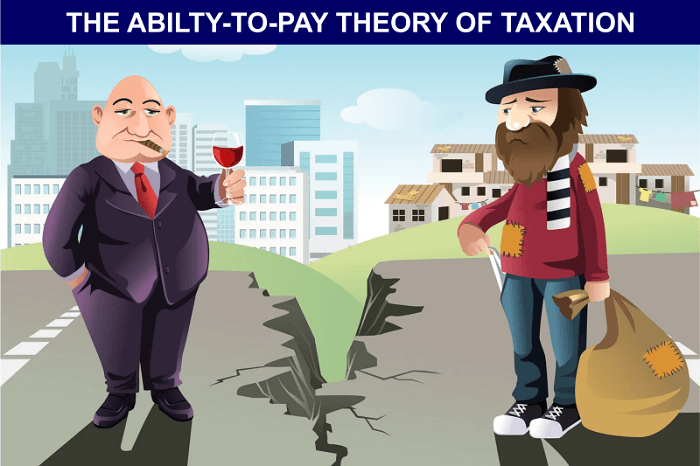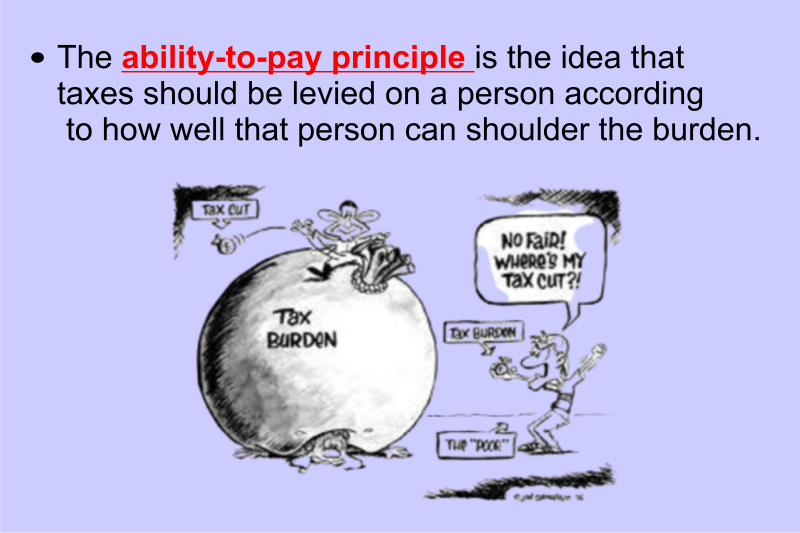Ability-To-Pay TaxationThe ability to pay taxation is a famous principle of taxation that states that taxes should be imposed based on the taxpayers' ability. That means higher taxes should be levied on those earning higher income while the taxes should be low for those with less income. It signifies that the levying of taxes should be according to the earning capacity of the taxpayer. 
The thought behind this theory of taxation is that those who have earned very high incomes use more resources available in society, so it is their duty to contribute to society as per their capacity. History of the Concept of Ability-To-Pay TaxationThe great economist Adam Smith launched the concept of the ability to pay taxation in 1776. He wrote about a form of taxation that ought to be implemented for the betterment of society, which was similar to the ability to pay taxation. He stated that every state subject ought to contribute to society or support the government in developmental works in proportion to their abilities. Their abilities should be proportional to their income so that they can contribute to society and support the government through taxes and financial protection. Understanding the Ability-To-Pay Taxation with ExampleSuppose there are two-person X and Y, the income of X is Rs. 10,00,000/- and the income of Y is Rs. 5,00,000/-. The tax paid by each of them is Rs. 1 lakh. Is it fair? For X, paying Rs.1 lakh as taxes will not bother him as he still has Rs 9 lakh for his expenses and savings, and he can survive lavishly on his remaining income. Y also pays the same tax, Rs. 1 lakh, and his net income after paying the tax is Rs 4 lakh. With this income, person Y realizes a financial crunch at the end of the month. It becomes a matter of concern for him to pay taxes because that destabilizes his financial position. From the above two cases, for person X, taxation is not a concerning factor, as his income is very high, but in the case of person Y, taxation is proving to be a big financial burden for him. The difference between the income level of both the person is huge, while the taxation level is the same. Now, if the taxation is fixed not in absolute terms but in the percentage of the income, for instance, the rate of taxation is fixed at 10% of the income. This time, the tax paid by person X will be 10% of Rs.10 lakh, which will be Rs.1,00,000/- for him. The tax payable by Y based on his income will be 10% of Rs. 5 lakhs, which amounts to Rs 50,000/- for him. Here we can see the difference in the taxes payable by X and Y. Y's income is half of X's income, so the tax payable by Y is also half the tax payable by X. This is the theory of ability to pay taxation. 
Positive Feedback about the TheoryGenerally, people support this theory of taxation. They believe that rich people of the society must support society in proportion to what they receive from society. For the country's development, the ones who are capable of supporting must support others in need. So, through this form of taxation, the government takes money from those who have more and use that money for those who have less. Negative Feedback on the TheoryThere are also some negative notions about this concept of taxation. It is said that it is unfair to those who have done hard work and become rich. It is like a penalty for working hard and earning high. They believe the tax rate should be equal and flat, not proportional to income. The Bottom LineThe theory of the ability to pay taxation theory is morally acceptable. It is a very good concept because everyone should contribute according to their capability; otherwise, this contribution becomes a burden for some people. Consequently, the burdened taxpayer may look for an illegal way to escape from the taxes. |
 For Videos Join Our Youtube Channel: Join Now
For Videos Join Our Youtube Channel: Join Now
Feedback
- Send your Feedback to [email protected]
Help Others, Please Share









